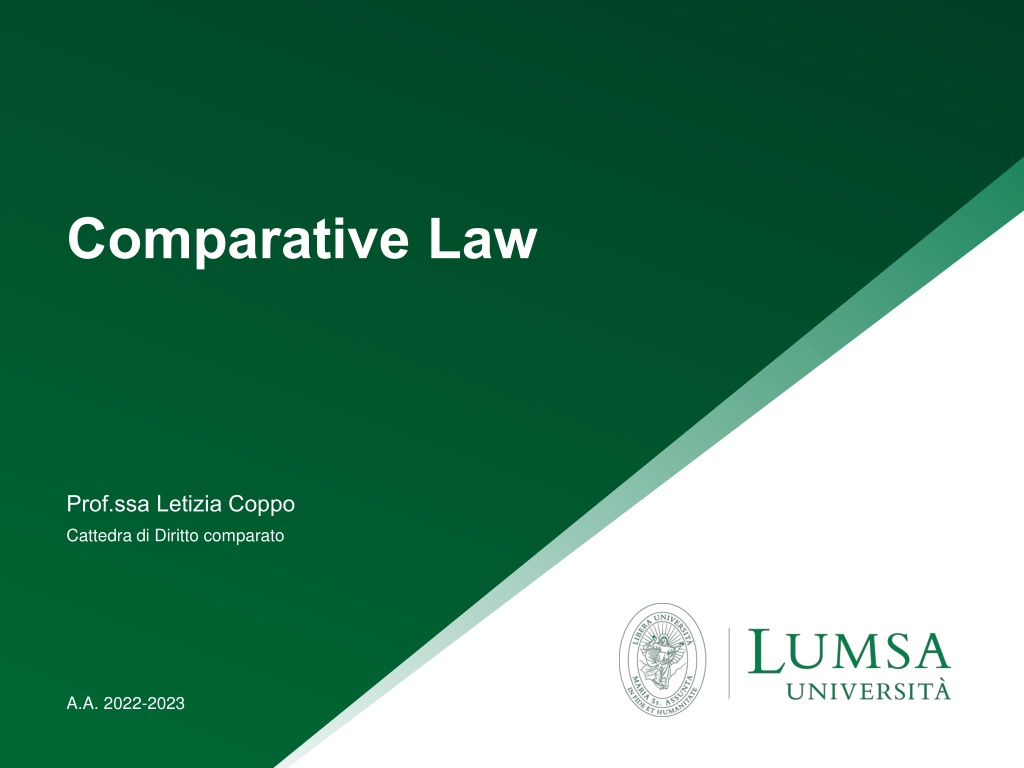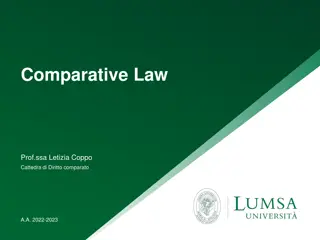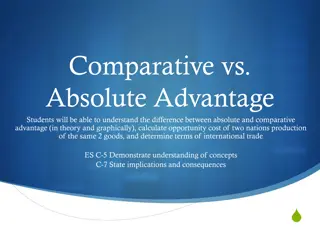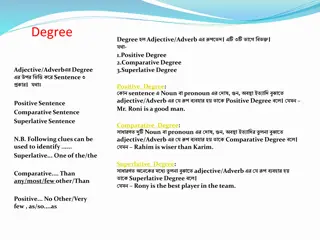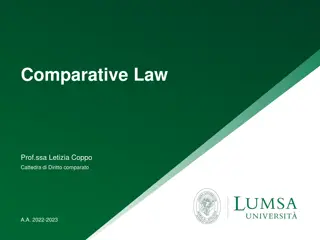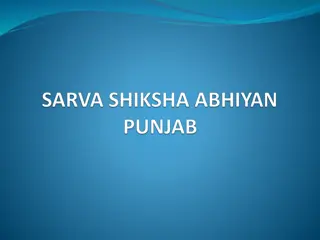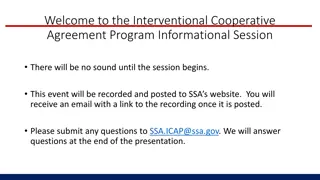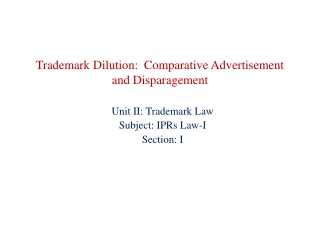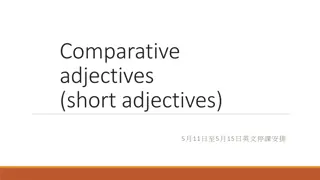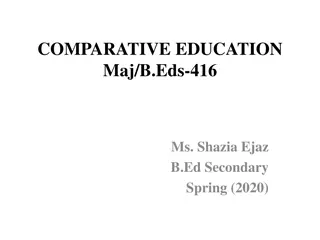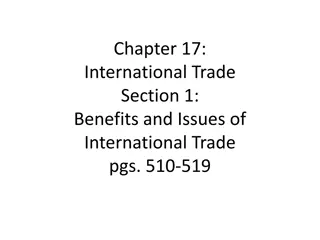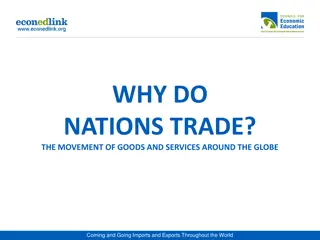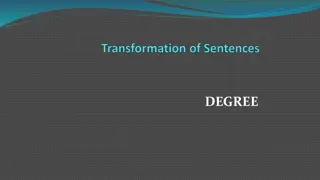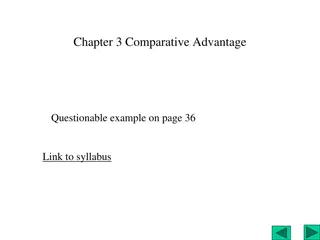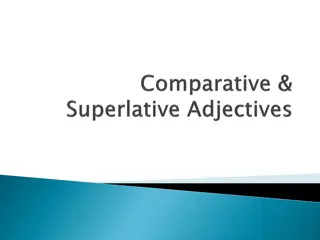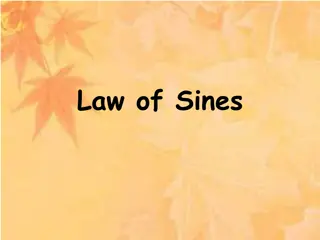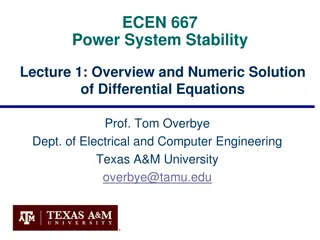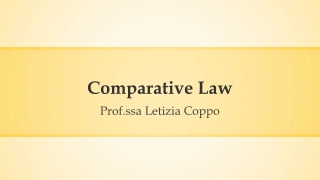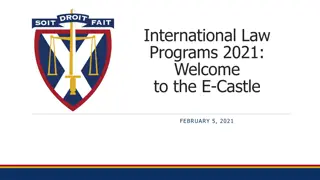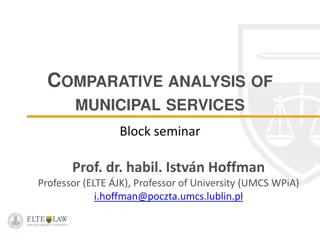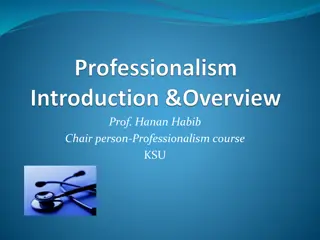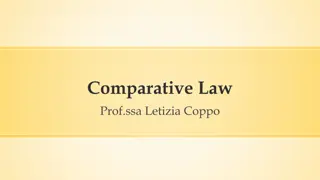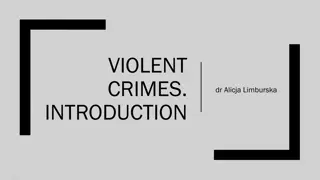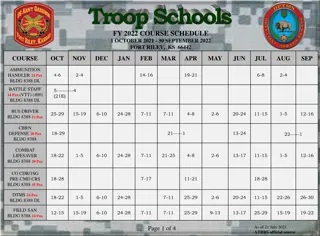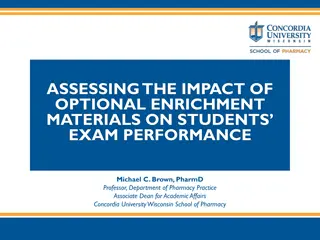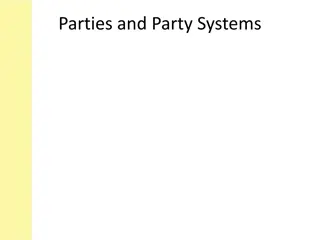Comparative Law Course Overview for A.Y. 2022-2023 by Prof.ssa Letizia Coppo
Dive into the world of comparative law with Prof.ssa Letizia Coppo in the academic year 2022-2023. The course covers key legal systems worldwide, including Western, Eastern, and religion-based traditions. Explore the impact of technological and digital revolutions on global law, legal transplants, uniformity, and cultural exchange.
Download Presentation

Please find below an Image/Link to download the presentation.
The content on the website is provided AS IS for your information and personal use only. It may not be sold, licensed, or shared on other websites without obtaining consent from the author. Download presentation by click this link. If you encounter any issues during the download, it is possible that the publisher has removed the file from their server.
E N D
Presentation Transcript
Comparative Law Prof.ssa Letizia Coppo Cattedra di Diritto comparato A.A. 2022-2023
THE COURSE IN A NUTSHELL Course structure and essentials will undertaking the final exam only on the remaining part of the programme (in this case the score of the preliminary test will be part of the final score) or undertaking the final exam on the whole programme (in this case the score of the preliminary test will be considered as refused). The students who passed the preliminary test but failed to attend more than 6 lectures before the end of the course will in any case lose the benefit of undertaking the final exam on a reduced programme. be entitled to choose between 60 hours, 10 weeks lectures + more interactive activities regular attendance highly recommended possible extra seminars class notes + suggested readings students attending on a regular basis: the final exam will be oral and in English language. Students who regularly attended the lectures will be entitled to undertake a preliminary test on part of the programme. Admission is subdued to the condition that the student has not failed to attend more than 3 lectures before the date of the test. Assessment will be in numbers (from 18 to 30 cum laude). Students who pass the test students non attending on a regular basis: oral exam in English at the end of the course. 2 Universit LUMSA
THE COURSE IN A NUTSHELL What are we talking about? After a first part devoted to the concept of comparative law, to the role of that science and the comparative law method, the course will analyse, in a perspective the distinctive elements of the main legal systems of the world, namely the Western legal tradition, with its paramount distinction between civil law and common law; the Eastern legal tradition and the religion-based legal traditions (Islamic law, African law, Chinese law, Hindu law). synchronic and diachronic 3 Universit LUMSA
THE COURSE IN A NUTSHELL What for? The technological revolution reduced the physical distance among countries, encouraging people to travel cross- borders The digital revolution increased the transnational dimension of exchanges. LAW GLOBALISATION 4 Universit LUMSA
THE COURSE IN A NUTSHELL What for? Circulation of laws (the so-called legal transplants) Need for uniformity and harmonisation Sources pluralism and complexity Circulation of contractual models ( alien contracts ) Transfer of functions from the State to the Market Creation of a third legal order named lex mercatoria Cultural cross-contamination 5 Universit LUMSA
THE COURSE IN A NUTSHELL What for? Providing knowledge Extending and enriching the supply of solutions Improving the scholars critical capacity to find the best one 6 Universit LUMSA
THE COURSE IN A NUTSHELL What for? an aid to the legislator a useful tool of construction a fundamental step of legal education a tool for law unification and harmonisation a glimpse into the common roots of the European legal tradition 7 Universit LUMSA
THE COURSE IN A NUTSHELL What do I expect from you? Develop legal English skills Learn the methods of macro and micro comparison Become familiar with the main legal formants influencing the evolution of private law Develop sensitivity for law harmonization 8 Universit LUMSA
THE COURSE IN A NUTSHELL What can you expect from me? Dialogue and discussion; care for legal reasoning and critical thinking Accuracy in the legal vocabulary Understanding of possible language and law related difficulties Monitoring and mentoring 9 Universit LUMSA
LET US BEGIN OUR JOURNEY!!! Credits: L Atelier che non c di Michele Battistella
The comparative method Golden rules
THE COMPARATIVE METHOD Golden rules Starting point: legal rules are not identical anywhere in the world and the solutions adopted to legal problems vary from system to system. Definition of comparative law: the science that studies law (i.e. the different legal systems of the world*) through the comparative method. *a legal system is more than just a set of legal rules; and law is not reduced to legislation 12 Universit LUMSA
THE COMPARATIVE METHOD Golden rules Macro-comparison: comparison on a large scale; it deals with the spirit and style of different legal systems, i.e. methods of handling legal materials, procedures for resolving and deciding disputes or the role of the various legal players, and the like. Micro-comparison: comparison on a small scale, i.e. focused specific legal institutions or problems, in other words, on the rules applied to actual problems or particular conflict of interests 13 Universit LUMSA
THE COMPARATIVE METHOD Golden rules Legal systems may have formally identical rules and though solve the same problem in different ways; or have formally different rules and reach the same results in their application. comparison must never be restricted to normative provisions or remain confined to a formal level. One thing are rules, another one is how they are interpreted and applied. 14 Universit LUMSA
THE COMPARATIVE METHOD Golden rules Legal formants: a legal system is the result of the interaction among various forces or factors that mutually influence each others. We must learn how to: distinguish between operational rules and how the rules are conveyed discern the various formants and understand their role 15 Universit LUMSA
THE COMPARATIVE METHOD: GOLDEN RULES Main legal formants Legislation Scholarship Case-law 16 Universit LUMSA
THE COMPARATIVE METHOD: GOLDEN RULES Criticalities Formants often overlap, raising problems of legitimacy, and often contain other formants (e.g. in judicial decisions we can distinguish between the held, the applied rule, the ratio decidendi and the obiter dictum) Each system has its crypto-types 17 Universit LUMSA
THE COMPARATIVE METHOD: GOLDEN RULES Crypto-types Formants system (and may be expressed in other systems); one thing is following rules, another is being aware of them. which are implied in the 18 Universit LUMSA
THE COMPARATIVE METHOD: GOLDEN RULES Steps of the comparative method process 1. Choose what systems to compare (i.e. the term of comparison): here the key-word is functionality, which tells you what laws to compare and the scope of the undertaking 2. Identify the legal problems you want to compare and contrast (i.e. the object of comparison) 3. Identify the relevant material and sources for comparison (i.e. where to look in the foreign systems) 4. Build a system 5. Assess findings critically 19 Universit LUMSA
THE COMPARATIVE METHOD: GOLDEN RULES 1. The choice of the term of comparison Focus on the parent system rather than / prior to the affiliate system (but bear in mind that to qualify a system as a mere affiliate is a delicate matter) First look at the parent system of the great legal families Choose according to the features of each system and the nature of the problem you want to analyse (have a look at national law reviews to get a grasp of hot topics) 20 Universit LUMSA
THE COMPARATIVE METHOD: GOLDEN RULES 2. The choice of the object of comparison Do not jump to the conclusion that the problem is unknown to the foreign system Rethink the original question purging it of all dogma from your system Eradicate preconceptions of your native legal system Do not underestimate the refinement of non continental legal system (see the example of trust) If the problem is really is unknown, then wonder why 21 Universit LUMSA
THE COMPARATIVE METHOD: GOLDEN RULES 3. The choice of the sources and materials to compare Avoid all limitations and restraints, especially with reference to sources (both imagination and discipline are needed) Bear in mind that sometimes legal systems solve problems with extra-legal means (see the example of the sending/receipt rule as to the question when an offer is considered as binging). Presumption of similarity: tells you where to look and whether convergences and divergences are real or only apparent. 22 Universit LUMSA
THE COMPARATIVE METHOD: GOLDEN RULES 4. The building of a system Draft separate reports for all the legal systems you have compared Comment each report Adopt a new viewpoint freeing each solution from their context and looking at them in light of their functions Develop a special syntax and vocabulary with concepts wide enough to embrace heterogeneous legal institutions functionally comparable Check the coherence of the system 23 Universit LUMSA
THE COMPARATIVE METHOD: GOLDEN RULES 5. The critical assessment of findings Build a structure and all the conceptual apparatus for ordering, organising and transmitting its materials after having induced it through constant experiments of comparative law. Create topical and categories 24 Universit LUMSA
THE COMPARATIVE METHOD: GOLDEN RULES Language-related criticalities Sometimes systems use concepts or words that do not find their mirror ones in other systems, as they do not belong to their legal categories or legal vocabulary (e.g. equity, tzar ). What must be borne in mind is that legal concepts belong to two systems: the linguistic and the legal one. Problems of translation: different systems have different linguistic structures and different rhetoric figures (e.g. contract and contrat) and they are full of false friends and traps 25 Universit LUMSA
THE COMPARATIVE METHOD: GOLDEN RULES Possible solutions to translation problems Sometimes it is better not to translate the concept, leave it in its original language Sometimes correspondence there is a semantic and conceptual Sometimes it is necessary to measure the divergence in meaning and assess whether understanding of the concept it undermines the Sometimes a neologism is needed 26 Universit LUMSA
The comparative method Benefits and practical applications
THE COMPARATIVE METHOD: BENEFITS & APPLICATIONS The comparative method as an aid to the legislator Legislators have found that on many matters good laws cannot be produced without the assistance of comparative law, whether in the form of general studies or of reports specially prepared in the topic in question. Instances: XIX century unification of German Law (private law, civil procedure, criminal law, bankruptcy law, court system organisation); dissolution of former Soviet Union countries. 28 Universit LUMSA
THE COMPARATIVE METHOD: BENEFITS & APPLICATIONS The comparative method as a tool for interpretation Key question: are national jurists entitled to a comparative-law-oriented or a harmonisation-oriented interpretation of domestic legislation? Possible answer - Such interpretation cannot turn into a circumvention of national law. - So, jurists are entitled to such interpretation provided that they use it to fill the gaps of domestic law. - Regardless of gaps, comparative interpretation can always be an argument to select between the two possible meanings of an ambiguous provision. 29 Universit LUMSA
THE COMPARATIVE METHOD: BENEFITS & APPLICATIONS The comparative method as a tool for interpretation comparative-law-oriented or harmonisation-oriented interpretation seems to be allowed in some countries* * As to legislation, see the Swiss Civil Code, art. 1, pars 2 e 3: if no statutory provisions can be found, the judge must apply customary law, failing which he must decide according to the rule he would, were he a legislator, decide to adopt. In so doing the judge must follow accepted doctrine and tradition . 30 Universit LUMSA
THE COMPARATIVE METHOD: BENEFITS & APPLICATIONS The comparative method as a tool for interpretation And interpretative tool in many cases, also through the quotation of foreign precedents* actually courts do use comparative law as an See, e.g. the influence of French case-law on the issue of wrongful birth / wrongful life. Or see the English case Interfoto Picture Library v. Stiletto Visual Programmes (available within the course materials), about good faith in precontractual negotiations. 31 Universit LUMSA
THE COMPARATIVE METHOD: BENEFITS & APPLICATIONS A fundamental step in legal education Improved awareness and respect of other cultures Better understanding of domestic law Learning of practical skills useful for facing the challenges of the globalisation of legal professions. 32 Universit LUMSA
THE COMPARATIVE METHOD: BENEFITS & APPLICATIONS A tool for law unification or harmonisation In identifying the real and apparent convergences and divergences among the various reporting them, comparative law experts play a paramount role in promoting the unification and harmonisation of law. legal systems and Think of scholarly initiatives like Unidroit or PECL or UNCITRAL or the Common Core; or think of the CISG Advisory Council or the Lawyer Linguists working at the European Union. 33 Universit LUMSA
Prof.ssa Letizia Coppo Email: lcoppo1@lumsa.it lcoppo@univ-catholyon.f r
